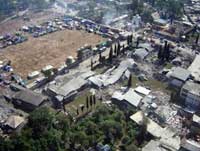10 scientific events in 2005
Here are the 10 most notable scientific events in 2005 according to LiveScience magazine
Natural disaster

The body of the dead died after Hurricane Katrina passed
- Nightmare about storms
2005 was the most stormy year in history. The US National Hurricane Center itself could not predict the number of storms. Earlier, the center predicted there would be 18-21 Atlantic storms but the actual number was much higher, exceeding the number of Roman letters (used to name the storm) and they were forced to Use more Greek letters. As of 2005, people will definitely remember Katrina, the biggest storm ever hit the United States, causing more than $ 125 billion in losses.

The ruined scene after the earthquake
- Earthquake
Besides storms, earthquakes are also a natural disaster that people have to resist helplessly this year. Most notably, the magnitude 7.6 earthquake shook Pakistan's already impoverished country and claimed more than 80,000 lives. Besides, there are other smaller earthquakes but also cause heavy damage to people in China and Japan .
Space

Object 2003UB313
- Discovering the '10th planet' in the solar system?
It is not yet known whether this 2003UB313 code object could be called a planet because a planet's norm has not been agreed upon by the scientific world. This object is considered to be the largest in the solar system since humans discovered Hai Vuong crystal in 1846 and greater than 1.5 times Pluto - the ninth planet. 2003UB313 lies 97 times farther away from the Sun.
- Sea ice on the red planet
The Mars Express probe flying on orbit around Mars has sent to Earth photographs of a giant sea of ice just below the surface of the planet, the equator. According to estimates, this sea ice has an area of 800x900km with a depth of about 45m. This is the result of a flood about 5 million years ago and over time, sediment has covered this ice. If these statements are correct, it will be the basis for further research on life on Mars.

Black hole of the universe
- Black hole appears
Scientists for the first time know about a type of black hole that creates new stars instead of sucking anything near, including light. The stars around this black hole are formed less than a light-year away. This new star has a mass of 30-50 times that of the Sun and is 100,000 times brighter than the Sun because it burns hydrogen at a much faster rate. In the next 5 million years, 80% of this cluster will explode and produce new black holes.
Archeology
- The oldest ruins of modern people
In fact, the skulls of Omo I and Omo II were found along the Omo River, Kibish district, Ethiopia since 1967, but it was not until 2005 that scientists reached a solid conclusion about their dates. Accordingly, the two skulls are about 200,000 years old and become the oldest remnants of modern humans found to date. In most of the previous cases, evidence of modern people dates back only about 50,000 years. This means that in 150,000 years ago, Homo Sapien existed without any cultural materials, music and tools.
Research and experiment
- Complete rice genetic map
Everyone knows the importance of rice in human life. Therefore, the rice genome is completely decoded deserves a big event. Rice has a genome similar to corn, wheat, barley, sugarcane . so it is definitely the study of other types of food within human reach. Genetic mapping of rice will help increase productivity and the ability to prevent pests.
- The role of nano
Nanotechnology, the science of microscopic matter, is growing. The size of a nanoparticle is less than 100 nanometers (1 nanometer is 1 billionth of a meter). Scientists are gradually bringing nanotechnology into human life, especially medicine. The world is waiting for experiments to apply nanoparticles to human cancer. Accordingly, nanotechnology will help produce drugs that can attack targets accurately, in addition to less toxic chemotherapy and surgical applications.

The first cloned dog
- Human morality
In February 2004, Professor Hwang Woo Suk, a pioneer in the field of cloning in Korea, announced the success of the first human embryo in the world. In 2005, he produced the first cloned dog. But by the end of the year, a scandal related to this professor appeared on the mass media. Colleague Roh Sung Il accused Hwang of deception in studying stem cells, and also raised questions about the exchange of germ cells in his work.
Medical
- First face transplant
 At the end of November, the moral issue and limitations of human organ transplantation were blown up when doctors first performed the entire face transplant surgery for the first time in the world. a French woman.
At the end of November, the moral issue and limitations of human organ transplantation were blown up when doctors first performed the entire face transplant surgery for the first time in the world. a French woman.
This woman's face was seriously injured and could not be recovered by conventional surgical techniques. After the transplant, the woman brought the face of the donor.
PHUONG NGUYEN
- 10 most outstanding scientific events in 2016
- Famous mystical events in history
- 10 outstanding science and technology events 2014
- The most notable scientific events in 2017
- 10 typical scientific and health events in 2005
- 10 outstanding scientific events in the world in 2018
- The 2011 event looks from the universe
- 2010 - Missed events
- Looking back at the outstanding scientific events in 2015
- 10 Vietnamese science and technology events in 2008
- 10 outstanding scientific and technological events in 2005
- Movement of the scientific world in the past week
 Vietnam 5th Asian champion on fuel-efficient vehicles
Vietnam 5th Asian champion on fuel-efficient vehicles We can read all NASA studies completely free of charge
We can read all NASA studies completely free of charge Singer and songwriter Bob Dylan won the 2016 Nobel Prize for Literature
Singer and songwriter Bob Dylan won the 2016 Nobel Prize for Literature Scientific revolution in Asia
Scientific revolution in Asia